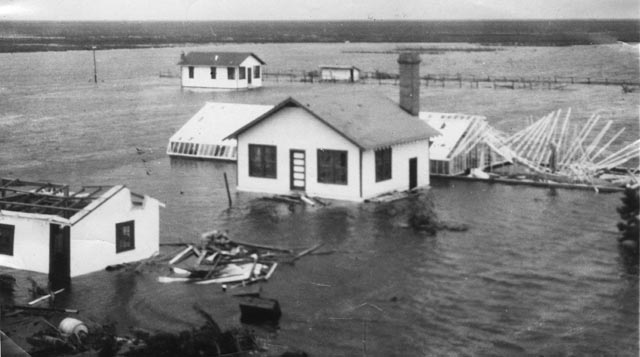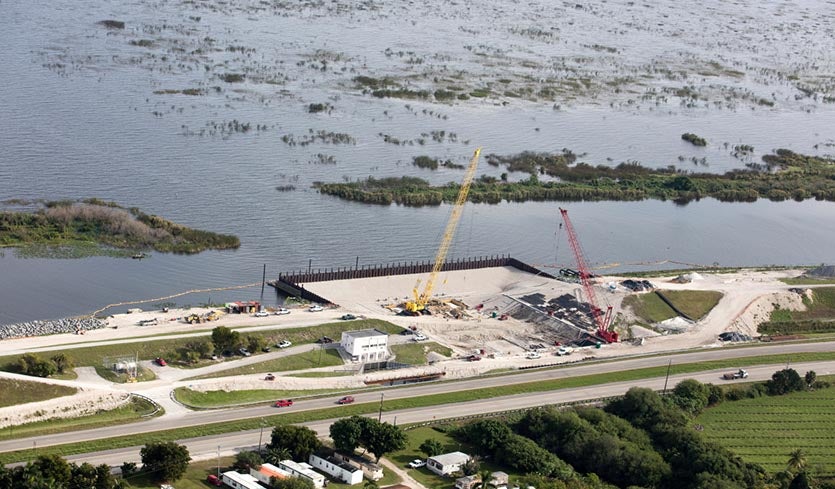| Above: With Lake Okeechobee in the background, crews work to replace a water control structure, or "culvert" in Herbert Hoover Dike along Highway 27 near Clewiston on December 23, 2015. The culvert replacements include installation of a temporary cofferdam to hold back water while crews work on the earthen structure. Image credit: USACE. |
After Hurricane Irma dumped widespread rainfall amounts of 8 – 12” on September 10 – 12 over much of Florida, the Army Corps of Engineers is battling to draw down the level of Lake Okeechobee. The lake level has risen more than 2.5 feet since the hurricane departed, and will likely reach its highest level in ten years next week as flood waters from Irma’s rains continue to arrive. A new concern are rains of 1 – 4” expected this weekend from slow-moving tropical disturbance Invest 99L, currently over Cuba, which will bring additional inflows to the lake. Under ideal conditions--with no inflows into the lake--the Army Corps can only lower the lake level by about 0.4" per day. The lake level stood at 16.3’ above sea level on Thursday, well above the maximum 15.5’ level the Army Corps of Engineers tries to maintain in order to relieve pressure on the aging Herbert Hoover Dike that surrounds the lake. The current high-water levels do not present an immediate danger to the dike, but should another hurricane bring widespread rain amounts of 10+ inches to Florida sometime in the next month, there will be an increasing danger of failure several weeks after the hurricane passes.
 |
| Figure 1. Rainfall from Hurricane Irma over Florida. Irma brought widespread rainfall amounts of 6 – 15” to the Lake Okeechobee watershed, which runs north-northwestward from the lake to the Orlando region. Image credit: NWS Tampa Bay. |
 |
| Figure 2. Water level of Florida's Lake Okeechobee between January 2016 and September 28, 2017, compared to historical levels from 1931 - 2016. The Army Corps tries to keep the lake level below 15.5'; the dike surrounding the lake is in danger of failure when the lake level hits 18.5' (red line), and is likely to fail when the water level hits 21'. When the lake level hits 17’, the Corps switches from weekly inspections of the dike to daily ones. Lake Okeechobee reached an elevation of 18.6' and 18.5' in 1995 and 1998, and since its construction in 1931, has never been above 18.7’. Image credit: Army Corps of Engineers. |
Lake Okeechobee’s dike is old and frail
Lake Okeechobee’s one cubic mile of water represents an important source of fresh water to South Florida, but also poses a grave danger. The 143-mile long Herbert Hoover Dike surrounding the lake was built in the 1930s out of gravel, rock, limestone, sand, and shell using old engineering methods. The dike is tall enough that it cannot be overtopped by a storm surge from anything but an extreme hurricane, since it rises to a height of 25 - 30 feet above normal lake stage, which is 15 ft above mean sea level. Hurricane Irma’s winds and storm surge did only minor damage to it on September 10 - 11. However, the dike is vulnerable to leaking and failure when heavy rains bring high water levels to the lake. A 2011 risk assessment estimated the dike's probable failure rate at every fourteen years, and a 2008 Army Corp of Engineers study said this about the vulnerable dike:
"There is limited potential for a dike failure with lake levels as low as 18.5 feet. The likelihood of a failure increases at higher lake levels. At a lake level of 21 feet--a 1-in-100-year flood event--a dike failure would be likely at one or more locations. In the event of a dike failure, waters from Lake Okeechobee would pass through the breach--uncontrollably--and flood adjacent land. Flooding would be severe and warning time would be limited. And with 40,000 people living in the communities protected by the Herbert Hoover Dike, the potential for human suffering and loss of life is significant. Our engineering studies indicate the southern and eastern portions of the dike system are more likely to fail than the northern and western portions of the dike. In general, we would expect a warning time of 24 to 48 hours prior to a dike failure that releases water from the lake; however, under some conditions the warning time might be longer, and under others, a dike failure could occur with no warning." Belle Glade (population 18,000) on the southeast shore of the lake, is 16' above sea level, so if Lake Okeechobee is at 21' above mean sea level and the dike fails, 4 - 5 feet of water could inundate the town.
According to palmbeachpost.com, in the wake of the hurricanes of 2004 and 2005, the Army Corp of Engineers embarked upon a $1.9 billion project to fortify the dike, which is now about half done. A 22-mile cutoff wall between Pahokee and Belle Glade has been completed, and many aging culverts around the lake’s 143-mile perimeter have been replaced. Still, the dike remains a Level 1 risk, considered by the corps to be the most likely to fail. In 2016, the U.S. Army Corps of Engineers completed an evaluation known as the Herbert Hoover Dike Dam Safety Modification Study (HHD DSMS) to address problems and develop alternatives for rehabilitation of the dike.
 |
| Figure 3. Aftermath of the 1928 Okeechobee Hurricane, showing damage to a cluster of Everglades scientific work stations in Belle Glade, on the southeast shore of Lake Okeechobee. The hurricane killed 2,500 people, mostly near Belle Glade, which was inundated by 7’ of water. Image credit: University of Florida, via the historicpalmbeach.com. |
The Great 1928 Lake Okeechobee Hurricane
The shores of Lake Okeechobee are the site of the second deadliest weather disaster in U.S. history--the 1928 Okeechobee Hurricane. This mighty hurricane caused catastrophic damage where it struck the Florida coast as a Category 4 storm near Palm Beach, and weakened only slightly to Category 3 strength with 130 mph winds when it passed over Lake Okeechobee. The powerful winds of the hurricane brought a 12' storm surge to the south end of the lake, which overwhelmed the 6' high levees protecting the farm lands to the south. The resulting flood covered an area of hundreds of square miles with water up to 20' deep, and killed at least 2,500 people--mostly black migrant farm workers. A mass grave at the Port Mayaca Cemetery east of Port Mayaca contains the bodies of 1,600 victims of the hurricane. The Herbert Hoover Dike was built in the 1930s around most of Lake Okeechobee in response to this disaster.
Lake Okeechobee pollution threatens water quality on both coasts of Florida
The Corps began dumping water out of Lake Okeechobee as fast as possible beginning on September 19. The excess water is being sent out the lake’s western drainage canal into the Caloosahtchee Estuary, which empties into the Gulf of Mexico at Fort Myers. Additional waters are being sent eastwards into the St. Lucie River, where it drains into the Atlantic Ocean near Stuart through the Indian River Lagoon, and down the C-51 canal into the estuary by West Palm Beach--the Lake Worth Lagoon. Lake Okeechobee water is full of agricultural runoff and laden with fertilizers, and this polluted water, combined with polluted water coming from local runoff due to heavy rains, is likely to cause havoc in Florida’s coastal waters this fall, affecting oyster beds, sea grasses, mangroves, and wildlife. Aerial photos are already showing serious pollution occurring on the St. Lucie estuary, and toxic algae blooms like occurred during similar conditions in the summer of 2013 and again in 2016 are a threat to develop (see my 2013 blog post.) Some good news: on Wednesday, the Senate passed a bill that would authorize $110 million over the next five years for research into the causes and control of large algae blooms. The House now takes up the matter.
Bob Henson will have an update on the tropics, including Invest 99L, on Friday afternoon.



